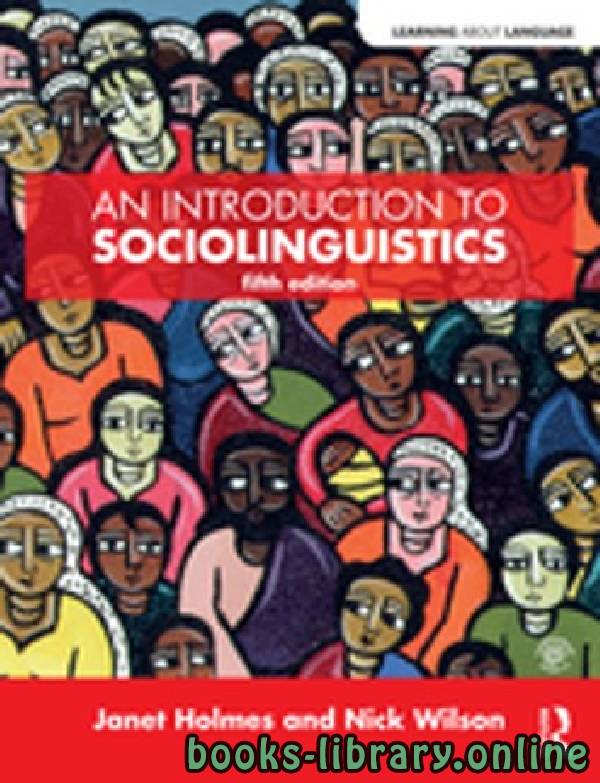📘 قراءة كتاب An_Introduction_to_Sociolinguistics أونلاين


هذا القسم يحتوى علي مجموعة من المصادر التي تهتم بدراسة اللغويات الإجتماعية.
اللغويات الإجتماعية هو فرع من علم اللغويات أو اللسانيات، يهتم بدراسة تأثير جميع جوانب المجتمع، ويتضمن ذلك المعايير الثقافية والتوقعات والبيئة وطريقة استخدام اللغة والآثار المترتبة على استخدام اللغة في المجتمع. وتختلف اللسانيات الاجتماعية عن اجتماعيات اللغة حيث تركز اللسانيات الاجتماعية على تأثير المجتمع على اللغة، بينما تركز اجتماعيات اللغة على تأثير اللغة على المجتمع. وتتداخل اللسانيات الاجتماعية إلى حد كبير مع علم التخاطب، ولها ارتباطاً تاريخياً وثيقاً مع علم الإنسان اللغوي، وقد حصل مؤخراً جدل حول الفرق بين المجالين.
ويَدرس هذا العلم أيضاً كيف تختلف لسن اللغة بين الجماعات التي تفصلها متغيرات اجتماعية معينة مثل العرق والدين والجنس والمستوى الاجتماعي ومستوى التعليم والعمر وما إلى ذلك، وكيفية استخدام إنشاء هذه القواعد والالتزام بها لتصنيف الأفراد في طبقات اجتماعية أو اجتماعية اقتصادية. وكما يختلف استخدام أي لغة من مكان إلى آخر (لكنة) يختلف استخدام اللغة أيضاً بين الطبقات الاجتماعية، وهذه هي اللهجات الاجتماعية التي يهتم علماء اللسانيات الاجتماعية بدراستها.
Sociolinguistics is the descriptive study of the effect of any and all aspects of society, including cultural norms, expectations, and context, on the way language is used, and society's effect on language. It differs from sociology of language, which focuses on the effect of language on a society. Sociolinguistics overlaps considerably with pragmatics. It is historically closely related to linguistic anthropology, and the distinction between the two fields has been questioned.
It also studies how language varieties differ between groups separated by certain social variables (e.g., ethnicity, religion, status, gender, level of education, age, etc.) and how creation and adherence to these rules is used to categorize individuals in social or socioeconomic classes. As the usage of a language varies from place to place, language usage also varies among social classes, and it is these sociolects that sociolinguistics studies.
The social aspects of language were in the modern sense first studied by Indian and Japanese linguists in the 1930s, and also by Louis Gauchat in Switzerland in the early 1900s, but none received much attention in the West until much later. The study of the social motivation of language change, on the other hand, has its foundation in the wave model of the late 19th century. The first attested use of the term sociolinguistics was by Thomas Callan Hodson in the title of his 1939 article "Sociolinguistics in India" published in Man in India. Sociolinguistics in the West first appeared in the 1960s and was pioneered by linguists such as William Labov in the US and Basil Bernstein in the UK. In the 1960s, William Stewart and Heinz Kloss introduced the basic concepts for the sociolinguistic theory of pluricentric languages, which describes how standard language varieties differ between nations
Contents
1 Applications
2 Traditional sociolinguistic interview
3 Fundamental concepts
3.1 Speech community
3.2 High prestige and low prestige varieties
3.3 Social network
4 Differences according to class
4.1 Class aspiration
4.2 Social language codes
4.2.1 Restricted code
4.2.2 Elaborated code
4.2.3 The codes and child development
4.3 Covert prestige
5 Sociolinguistic variables
Applications
For example, a sociolinguist might determine through study of social attitudes that a particular vernacular would not be considered appropriate language use in a business or professional setting. Sociolinguists might also study the grammar, phonetics, vocabulary, and other aspects of this sociolect much as dialectologists would study the same for a regional dialect.
The study of language variation is concerned with social constraints determining language in its contextual environment. Code-switching is the term given to the use of different varieties of language in different social situations.
William Labov is often regarded as the founder of the study of sociolinguistics. He is especially noted for introducing the quantitative analysis of language variation and change, making the sociology of language into a scientific discipline.
Traditional sociolinguistic interview
The sociolinguistic interview is an integral part of collecting data for sociolinguistic studies. There is an interviewer, who is conducting the study, and a subject, or informant, who is the interviewee. In order to get a grasp on a specific linguistic form and how it is used in the dialect of the subject, a variety of methods are used to elicit certain registers of speech. There are five different styles, ranging from formal to casual. The most formal style would be elicited by having the subject read a list of minimal pairs (MP). Minimal pairs are pairs of words that differ in only one phoneme, such as cat and bat. Having the subject read a word list (WL) will elicit a formal register, but generally not as formal as MP. The reading passage (RP) style is next down on the formal register, and the interview style (IS) is when an interviewer can finally get into eliciting a more casual speech from the subject. During the IS the interviewer can converse with the subject and try to draw out of them an even more casual sort of speech by asking him to recall childhood memories or maybe a near death experience, in which case the subject will get deeply involved with the story since strong emotions are often attached to these memories. Of course, the most sought-after type of speech is the casual style (CS). This type of speech is difficult if not impossible to elicit because of the Observer's Paradox. The closest one might come to CS in an interview is when the subject is interrupted by a close friend or family member, or perhaps must answer the phone. CS is used in a completely unmonitored environment where the subject feels most comfortable and will use their natural vernacular without ov
ertly thinking about it.
An_Introduction_to_Sociolinguistics_by_J
An Introduction to
Sociolinguistics
Fourth Edition
vii
Preface xii
Author’s Acknowledgements xvi
Publisher’s Acknowledgements xvii
1 What do sociolinguists study? 1
Section I Multilingual Speech Communities 17
2 Language choice in multilingual communities 19
3 Language maintenance and shift 53
4 Linguistic varieties and multilingual nations 76
5 National languages and language planning 100
Section II Language Variation: Focus on Users 129
6 Regional and social dialects 131
7 Gender and age 159
8 Ethnicity and social networks 186
9 Language change 206
Section III Language Variation: Focus on Uses 237
10 Style, context and register 239
11 Speech functions, politeness and cross-cultural communication 274
12 Gender, politeness and stereotypes 301
13 Language, cognition and culture 337
14 Analysing discourse 363
15 Attitudes and applications 409
16 Conclusion 439
References 454
Appendix: phonetic symbols 475
Glossary 477
Index 479
Brief Contents
Section I Multilingual Speech Communities 17
2 Language choice in multilingual communities 19
C hoosing your variety or code 19
D iglossia 2 7
C ode-switching or code-mixing 34
3 Language maintenance and shift 53
L anguage shift in different communities 53
L anguage death and language loss 58
F actors contributing to language shift 60
H ow can a minority language be maintained? 64
L anguage revival 67
4 Linguistic varieties and multilingual nations 76
V ernacular languages 77
S tandard languages 78
L ingua francas 8 2
P idgins and creoles 85
5 National languages and language planning 100
N ational and official languages 102
P lanning for a national official language 1 07
D eveloping a standard variety in Norway 111
T he linguist’s role in language planning 1 15
Contents
Contents
Section II Language Variation: Focus on Users 129
6 Regional and social dialects 131
R egional variation 1 32
S ocial variation 1 39
S ocial dialects 1 40
7 Gender and age 159
G ender-exclusive speech differences: highly structured communities 1 59
G ender-preferential speech features: social dialect research 1 63
G ender and social class 1 64
E xplanations of women’s linguistic behaviour 1 67
A ge-graded features of speech 1 75
A ge and social dialect data 1 77
A ge grading and language change 180
8 Ethnicity and social networks 186
E thnicity 1 86
S ocial networks 1 96
9 Language change 206
V ariation and change 207
H ow do changes spread? 2 14
H ow do we study language change? 2 19
R easons for language change 2 22
An Introduction to Sociolinguistics
à An Introduction to Sociolinguistics _by_J
branches of sociolinguistics pdf
sociolinguistics summary pdf
an introduction to sociolinguistics wardhaugh 5th edition
sociolinguistics concepts
sociolinguistics briefly
characteristics of sociolinguistics
paragraph about sociolinguistics
sociolinguistics approaches
سنة النشر : 2013م / 1434هـ .
حجم الكتاب عند التحميل : 3.3MB .
نوع الكتاب : pdf.
عداد القراءة:
اذا اعجبك الكتاب فضلاً اضغط على أعجبني و يمكنك تحميله من هنا:

شكرًا لمساهمتكم
شكراً لمساهمتكم معنا في الإرتقاء بمستوى المكتبة ، يمكنكم االتبليغ عن اخطاء او سوء اختيار للكتب وتصنيفها ومحتواها ، أو كتاب يُمنع نشره ، او محمي بحقوق طبع ونشر ، فضلاً قم بالتبليغ عن الكتاب المُخالف:
 قبل تحميل الكتاب ..
قبل تحميل الكتاب ..
يجب ان يتوفر لديكم برنامج تشغيل وقراءة ملفات pdf
يمكن تحميلة من هنا 'http://get.adobe.com/reader/'


 منصّة المكتبة
منصّة المكتبة 